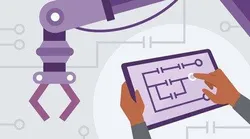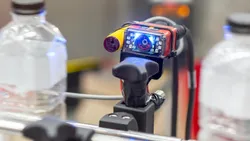
Become a PLC Developer 
This course will teach you how to become a PLC Developer. You will learn how to bridge software and hardware, create basic PLC logic, and sequence multiple actions with PLCs for repetitive tasks. This course is perfect for anyone looking to gain a better understanding of how to use PLCs to solve complex problems beyond the computer. Click now to start your journey to becoming a PLC Developer. ▼
ADVERTISEMENT
Course Feature
![]() Cost:
Cost:
Free Trial
![]() Provider:
Provider:
LinkedIn Learning
![]() Certificate:
Certificate:
Paid Certification
![]() Language:
Language:
English
![]() Start Date:
Start Date:
On-Demand
Course Overview
❗The content presented here is sourced directly from LinkedIn Learning platform. For comprehensive course details, including enrollment information, simply click on the 'Go to class' link on our website.
Updated in [August 31st, 2023]
Skills and Knowledge:
- Understanding of PLCs and how they bridge software and hardware
- Ability to create basic PLC logic
- Knowledge of sequencing multiple actions with PLCs
- Understanding of how to apply PLC logic across devices
- Ability to solve problems beyond the computer with PLCs
Professional Growth:
This course on becoming a PLC Developer contributes to professional growth in several ways:
1. Enhanced technical skills: By learning about PLCs and their unique programming logic, professionals can expand their technical knowledge and skills. This course provides insights into how PLCs bridge the gap between software and hardware, allowing individuals to gain a deeper understanding of automation scenarios and heavy-duty control systems.
2. Increased job opportunities: PLCs are widely used in various industries, including manufacturing, energy, and transportation. By becoming a PLC Developer, professionals can open doors to new job opportunities in these sectors. The demand for skilled PLC Developers is high, and completing this course can make individuals more marketable in the job market.
3. Problem-solving abilities: PLCs are designed to solve complex problems in real-time scenarios. By learning how to create complex interactions and sequences using PLCs, professionals can enhance their problem-solving abilities. This skill is valuable in any professional setting, as it demonstrates the ability to analyze and address challenges efficiently.
4. Efficiency and productivity improvement: PLCs are commonly used for repetitive tasks and automation. By learning how to sequence multiple actions with PLCs, professionals can optimize processes and improve efficiency in their work. This knowledge can lead to increased productivity and cost savings for organizations.
5. Versatility and adaptability: PLCs are used in a wide range of applications, from controlling machinery in factories to managing traffic signals. By gaining expertise in PLC development, professionals become versatile and adaptable to different industries and sectors. This flexibility can be advantageous for career growth and advancement opportunities.
Overall, this course on becoming a PLC Developer contributes to professional growth by expanding technical skills, increasing job opportunities, enhancing problem-solving abilities, improving efficiency and productivity, and fostering versatility and adaptability.
Further Education:
This course is suitable for preparing for further education. It provides an introduction to programmable logic controllers (PLCs) and teaches you how to create basic PLC logic and sequence multiple actions with PLCs. This knowledge can be applied across devices and can be useful in various industries that rely on automation. Understanding PLCs and their role in bridging software and hardware can be beneficial for further education in fields such as engineering, automation, and industrial technology.
Course Syllabus
Course 1: Learning Industrial Automation
Get an overview of industrial automation. Learn about the components, levels, software, and skills it takes to start a career as an automation engineer or technician.Course 2: Learning PLC Ladder Logic
Get started with PLC ladder logic programming. Explore fundamental topics and review case studies that can help you grasp the real-world application of these concepts.Course 3: PLC Ladder Logic Essential Training
Build your skills in industrial automation. Learn how to use ladder logic to program major PLC devices, including Allen Bradley, Siemens, and OMRON.Course 4: PLC Memory Organization
Find out how to optimize processes in PLC based on data. Learn details of data storage, how storage interacts with input and output, and how to approach memory structures.Course 5: PLC Sequencer Logic
Explore some of the essential sequencer instructions used in PLC ladder logic programming. Learn how to work with sequencer output, compare, and load instructions in this course.Course 6: PLC Program Flow and Control Instructions
Explore advanced PLC ladder logic programming instructions, including bit shift left, bit shift right, word shift operations, and subroutine instructions.Course Provider

Provider LinkedIn Learning's Stats at AZClass
Discussion and Reviews
0.0 (Based on 0 reviews)
Explore Similar Online Courses

Data Structures & Algorithms Using C++

Jakarta Persistence (JPA)

Python for Informatics: Exploring Information

Social Network Analysis

Introduction to Systematic Review and Meta-Analysis

The Analytics Edge

DCO042 - Python For Informatics

Causal Diagrams: Draw Your Assumptions Before Your Conclusions

Whole genome sequencing of bacterial genomes - tools and applications

PLC Memory Organization

PLC: Industrial Sensors


Start your review of Become a PLC Developer